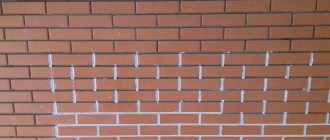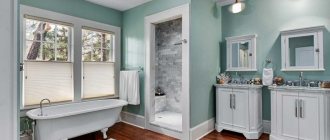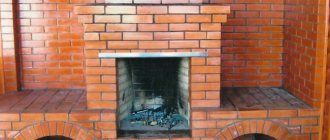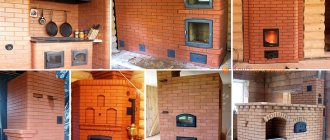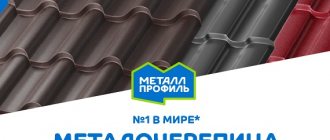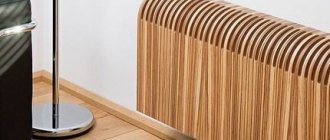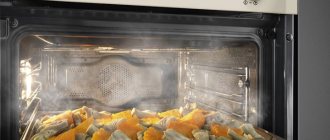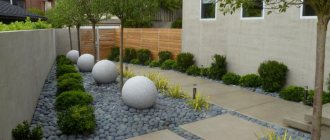Among the means for protecting surfaces heated to high temperatures, varnishes and heat-resistant paints for stoves and fireplaces can be distinguished. Their main feature is that they can cover not only metal, but also brick and concrete.
In order for you to find the best composition for treating a brick stove in your country house or in your own home, we have collected information about the top ten that are in demand on the market. The popularity of the product is justified by practical application and the solid reputation of the manufacturer. Taking into account our recommendations, the choice of product will be simple and clear.
Causes of wear and tear on chimneys
There are a large number of reasons that lead to wear and tear of the chimney.
- corrosion that occurs due to the impact of combustion products and flue gases on the masonry and other materials of the chimney;
- wind, humidity, precipitation, excessive heat;
- shortcomings in the design and construction of the pipe itself;
- unqualified intervention in the chimney system;
- when using the structure for other purposes, for example, when connecting artificial ventilation, the risk of destruction of the chimney increases;
- transition from one type of fuel to another;
- technologies, including “wet cleaning”, aimed at protecting nature;
- strong air injection from the boiler.
When using metal elements during construction, erosion may occur, which is also caused by unfavorable meteorological factors.
Materials for painting chimneys
To paint chimneys, it is necessary to select materials that match those from which the structure is made. They must withstand high temperatures and be resistant to external factors and weather conditions.
Most often, primer coatings are used before applying paint to the surface. The best option is gray enamel KO-8111. It can withstand high temperatures and cope with corrosion.
A good paint for a chimney is OS-12-03 enamel. If signal coloring is necessary, red or white colors are chosen. If this is not required, then you can purchase any other shade.
Organosilicon paints and varnishes are best suited for painting structures.
They are expensive, but justify their cost due to the following advantages:
- fire resistance;
- withstand high temperatures,
- resistant to moisture, acids, alkalis;
- have a smooth coating, which adds dirt-repellent properties;
- neutral to oxidation;
- have low surface tension.
In addition, when choosing, you should pay attention to the following parameters:
- the time during which the mixture dries (with long-drying options there is a risk of damage due to exposure to external factors);
- nominal viscosity;
- validity.
With the correct choice of paint and varnish material, the service life of the chimney increases. When painting with such materials, be sure to wear a respirator, gloves, and thick clothing. The compositions are toxic and can cause harm to health if safety precautions are not followed.
Scope of application
High temperature paint is used for painting:
- Radiators (heating radiators);
- Engine parts;
- Stoves, fireplace, barbecue.
Important! The manufacturer indicates the area of application on the packaging. When choosing, you should carefully read what surfaces this paint is suitable for.
To paint a product, object, part that gets very hot, use:
- Heat-resistant enamel. It is used to cover parts that heat up to 700 degrees C. Heat-resistant paint is suitable for coating stoves and fireplaces.
- Fireproof for iron. It can withstand open fire.
- High temperature enamel for painting a heating radiator. The paintwork can withstand temperatures up to 250 degrees. You can cover a brick oven or treat the seams.
- Heat-resistant enamel for coating objects that heat up to 300-350 degrees C.
Step-by-step instructions for painting a chimney
For work you will need the following tools and materials:
- brushes or rollers for painting;
- metal brush for cleaning the surface;
- acetone or other degreasing liquid;
- primer;
- paint and varnish composition suitable for the chimney material.
For chimney painting to be effective, the following steps must be followed:
- Calculation of the area to be painted. This step is necessary to calculate the amount of materials needed.
- Cleaning up. It is necessary to remove from the base anything that can interfere with painting and also affect the quality of work: old paint, grease, dirt, etc.
- Primer. Needed for better adhesion of paint to the surface.
Painting is the final stage in which the paint coating is applied. If marking coloring is necessary, you should be guided by the following standards corresponding to paragraph 1 of Art. 51
- Pipes with a height of up to 100 m are painted with horizontal stripes from 0.5 m to 6 m of white and red colors (at least there must be 3 stripes).
- For structures over 100 m, the size of the strips should be from 1/7 to 1/21 of the entire height of the object. The outer stripes should be red.
The paint is applied in 2-3 layers so that the thickness is 40-60 microns. The consumption for 1 layer of coating is 120-150 g/m².
Metal surfaces
Metal pipes are usually made of stainless steel, which is least susceptible to corrosion. However, any structure must be prepared before painting, otherwise painting on metal will not last long enough.
Rating of the best paints on today's market
The need to paint stoves, brick chimneys and fireplaces is quite common. Demand creates supply, so in stores you can find many compositions suitable for this purpose from Russian and foreign companies.
From the outside, an ordinary brick oven heats up to 60-90°C, and a sauna oven – up to 110°C. The temperature of the hob and combustion door can reach up to 400°C when heating with wood and up to 700°C when heating with coal. Therefore, the space near them can heat up to 140°C.
Thus, the paint that will be used to paint the stove must withstand temperatures up to 140°C and adhere well to brick or concrete. The above rating includes well-established and frequently sold brands from both well-known and poorly promoted manufacturers.
1st place – Elcon (varnish)
Special varnish from a well-known Russian manufacturer of heat-resistant paints. The appearance of the treated surface, depending on the number of layers, can be from matte to semi-glossy.
One can is enough for approximately 2 m2 of brickwork. For a standard size oven when painting in 1 layer, 2 of these sprays are required
Specifications:
- color: transparent;
- maximum temperature (°C): 250;
- packaging: spray can, jar;
- displacement (l): 0.52 (can), 0.8 (can);
- gloss: matte or semi-gloss.
Drying time is 3 hours, and for complete polymerization 3 days at room temperature are enough. The recommended number of layers is 1-2. Product consumption is 120-150 g/m2 for metal and up to 200 g/m2 for not very smooth brick.
The product is not demanding on application conditions. Work can be carried out at low temperatures and at high (up to 80%) relative humidity.
2nd place – Elcon (paint)
Russian-made paint often found on the market. One of its significant advantages is the possibility of machine tinting and achieving almost any color.
Black paint can withstand the highest temperatures (up to 1000°C). Then there are the color options: gray, gold and copper (up to 700°C)
Specifications:
- color: 250 shades;
- maximum temperature (°C): 250-1000;
- packaging: spray can, jar, bucket;
- displacement (l): 0.52 (can), 0.8 (can), 25 (bucket);
- gloss: matte or semi-gloss.
Pigmentation leads to a decrease in the maximum permissible temperature. But for many color solutions it is still quite high (600°C or more), so it can also be used to coat metal parts of brick stoves and fireplaces.
3rd place – Rust-Oleum Specialty High Heat
Universal enamel, with the best permissible temperature indicator among paints in this rating. But it has a fairly high price, since the company enjoys well-deserved respect due to the high quality of its products.
The paint has good qualities - it adheres reliably to the surface and dries quickly. The label and all the information are in English, but you can use the aerosol correctly without instructions
Specifications:
- color: transparent, black, aluminum;
- maximum temperature (°C): 1090;
- packaging: spray can;
- displacement (l): 0.52;
- gloss: matte.
This composition is used mainly for painting metal products, although it can also be applied to brick and concrete bases. This is very convenient, since one product can be used to treat both the walls of a stove or fireplace and very hot metal elements, without having to buy heat-resistant metal paint separately.
4th place – DAP Derusto Heat Master
This enamel is universal and suitable for painting surfaces made of brick, concrete and metal. Made in the USA. It has good quality and a high price.
In terms of its quality, this paint is similar to a higher-rated position, but is characterized by a lower maximum permissible temperature. But for brick surfaces this does not matter
Specifications:
- color: silver, black;
- maximum temperature (°C): 538;
- packaging: spray can;
- displacement (l): 0.52;
- gloss: matte.
Usually one coat is enough for painting, and the drying time is 4 hours. After this, it is necessary to carry out thermal hardening. The paint lasts a long time on the surface and is resistant to physical impact.
5th place – Dufa Scwarzer Peter
High-quality and expensive black enamel from a well-known German manufacturer is one of the best representatives of the “family” of heat-resistant enamels. It is expensive and has small packaging, so it is used only for covering small surfaces.
This paint is rarely used for stoves due to its high cost. But if you need to treat a small area, you can use it
Specifications:
- black color;
- maximum temperature (°C): 140;
- packaging: jar;
- displacement (l): 0.125;
- gloss: glossy.
Dufa products have lower temperature resistance than all other types presented in the rating. Therefore, before using this heat-resistant paint to cover the surface of a brick stove or fireplace, you need to make sure that the masonry does not heat up to temperatures above 140°C.
The paint does not require heat hardening. The interlayer drying period is a day, although usually only a single-layer coating is used.
6th place – Motip
Clear varnish made in Holland. The price is quite high, which, combined with the application of 2-3 layers, makes this product expensive. But the quality of this heat-resistant aerosol is very good.
The product under the Motip brand has very high heat resistance, which is not typical for clear varnishes. It can also be used on metal, such as a fireplace grate.
Specifications:
- color: transparent;
- maximum temperature (°C): 650;
- packaging: spray can;
- displacement (l): 0.4;
- gloss: matte.
The drying time between coats is only 5 minutes, and complete drying occurs in 40 minutes - these are good indicators.
In addition to varnish, there is also thermal paint from this company in black and silver, which is also suitable for processing brick.
7th place – Abordage
Made in China, Abordage's heat-resistant spray is used primarily for automotive applications, but can also be used to protect and decorate brick and concrete surfaces.
Another paint that is suitable for painting stoves and fireplaces. Does not stand out with any special properties compared to competitors
Specifications:
- color: silver, black;
- maximum temperature (°C): 200-300;
- packaging: spray can;
- displacement (l): 0.4;
- gloss: matte.
This spray produces bright and rich colors, so one coat is usually enough for high-quality coverage. The downside is the lack of heat-resistant color options.
8th place – Decorix
Decorix varnish is one of the most inexpensive heat-resistant paints on the market that can be used to coat stone, concrete or brick.
Like most heat-resistant varnishes, Decorix is sold in spray form. This is the most convenient form for applying a protective coating to a flat and large surface.
Specifications:
- color: transparent;
- maximum temperature (°C): 250;
- packaging: spray can;
- displacement (l): 0.52;
- gloss: glossy.
The temperature range at which Decorix varnish can be applied is from +10 to +30°C. Typically, 2-3 layers are sufficient for high-quality surface coverage.
It is necessary to maintain a gap of at least 30 minutes between them. One can is enough to paint an area of 1.5-2 m2.
9th place – Monarca
Spray paint made in China, which can be applied to different types of surfaces.
Quite a high-quality product from a brand not very well known in Russia. The high permissible temperature allows you to paint both brick and metal doors of the blower and firebox
Specifications:
- color: silver, black;
- maximum temperature (°C): 600;
- packaging: jar, spray can;
- displacement (l): 0.52;
- gloss: semi-gloss.
Based on an acrylic polymer, this spray dries quickly after application. The total drying time is only half an hour. To harden, you need to heat the brick. The can is enough for 3 m2 when painted in one layer.
Causes of wear and tear on chimneys
During prolonged exposure to high temperatures from 280 °C to 620 °C, the strength of materials decreases and they become less resistant to corrosion. The main reasons that lead to premature destruction of the chimney:
- new technologies aimed at protecting the environment, especially the “wet cleaning” system;
- too much air injection through the boiler-pipe system is also a negative factor;
- frequent or sudden changes in operating conditions;
- work in violation of design conditions;
- frequent change of fuel types.
Painting pipes is considered an effective protection against destruction. It is important to choose paint and varnish materials wisely in order to protect metal and reinforced concrete structures. It is necessary to take into account the operating conditions and surface features.
General concepts about heat-resistant paints
To ensure that the paint applied to the surface does not lose its original qualities for a long time under the influence of high temperatures, heat-resistant paints and varnishes are produced using special technology. They contain protective components, thanks to which the treated brick walls of stoves or fireplaces, and even outdoor barbecue complexes, are able to withstand aggressive external factors such as moisture, precipitation, dirt and dust. A layer is formed on metal elements that can protect them, among other things, from oxidative corrosion processes.
Heat-resistant paint in aerosol packaging
Almost all compositions for painting stoves and fireplaces are produced in the form of suspensions based on heat-resistant varnishes containing silicone and silicon.
As mentioned above, all parts of the structure can be painted, but for small metal elements and large surfaces, special types of paints are produced that are designed for extremely high temperatures. Such compositions are suitable not only for stoves, but also for barbecues, where the metal experiences maximum impact from contact with open fire.
Cast iron oven door, painted with a heat-resistant compound
Other heat-resistant paints are made specifically for treating brick or stone surfaces.
Compositions for coloring materials exposed to thermal effects must withstand heating of at least 350-400 degrees. So, even when ordinary paper burns on its surface, the temperature is + 380-400 degrees; on an intense flame when burning wood, it reaches + 400-450 degrees. Well, when coal is used as fuel, in the phase of its flameless combustion, a temperature is created on its surface that reaches + 900-1000 degrees.
Of course, the external surfaces of heating devices heat up much less than the firebox, but in any case you need to choose heat-resistant paints that can withstand from 400 to 550 degrees of heat.
Expert opinion: Afanasyev E.V.
Chief editor of the Stroyday.ru project. Engineer.
Most manufacturers make compositions for different purposes, and the temperature parameters are indicated on their packaging, which allows you to choose the right one for either metal elements or brick surfaces of the stove.
Why should you buy heat-resistant paint?
It should be noted that heat-resistant paints always have a fairly high price, and, wanting to save money, some stove owners try to use oil, enamel paints or water-based paints to paint their metal parts. However, you need to know how these compounds behave when heated:
Conventional paints are not suitable for extreme temperature operating conditions.
- For example, oil paint made from drying oil will first soften, and at very high temperatures it will begin to burn. Well, an unpleasant smell will come from it in any case.
- Ordinary enamel will dry out, lose elasticity and, accordingly, crack, while also emitting an unpleasant “aroma”.
- Water-based paint, applied in a thick layer, will quickly crack and crumble when moisture evaporates from it, and a thin layer will be covered with a fine network of cracks.
After two or three firings of the stove or fireplace, ordinary paints will change color and acquire an unpleasant yellowness. In addition, you need to remember that rust will negatively affect them from the inside, “eating” the paint and showing up on the outside. Such paints will not protect heated surfaces, and may even cause harm not only to the walls and parts of the stove, but also to the health of people who will breathe in caustic fumes.
In addition, such a coating will barely be enough even for one heating season, and after that the paint on the metal, and possibly on the bricks, will remain in areas that will be difficult to remove due to the porosity of the material.
It will also be difficult to remove oil or enamel paint from brickwork, and you cannot paint over it, as it will still release harmful substances and have a bad effect on the top renewed layer. You will have to clean the surfaces with a wire brush or a grinder with an appropriate attachment.
Therefore, you should not take risks, otherwise you will end up paying much more than the cost of high-quality heat-resistant paint.
Basic requirements for paints for stoves and fireplaces
When choosing heat-resistant paint, you need to consider several factors:
- Resistance of the composition to high temperatures. The maximum heating level is indicated on the packaging.
- Resistance to aggressive environments.
- Material consumption, that is, the amount required to paint 1 m².
- Composition of the dye.
- Ease of paint application.
Heat-resistant paint and varnish compositions are divided according to the base component on which they are made:
- Acrylic base.
- Silicon-containing (potassium or sodium liquid glass).
- Epoxy resins.
- Silicone.
The base of heat-resistant paint directly affects its performance.
The compositions themselves, made on an epoxy or silicone basis, are not very resistant to high temperatures. Therefore, to enhance heat resistance, aluminum or bronze powder is added to the paint, after which the composition can be used at temperatures up to 400-650 degrees.
Expert opinion: Afanasyev E.V.
Chief editor of the Stroyday.ru project. Engineer.
If you need to “strengthen” silicone paint only to 200-400 degrees, then polyurethane additives are included in its composition.
Heat-resistant paints are also divided according to their purpose, that is, according to the type of surface on which they are applied.
Paint for brick surfaces
Painting the brick surface of the stove
The following requirements apply to heat-resistant paints used to cover brickwork:
- resistance to temperatures reaching up to 300 degrees;
- resistance to steam and moisture, especially for stoves installed in bathhouses;
- crack resistance;
- resistance to fading.
Organosilicon compounds, which include enamels KO-168, KO-8101, KO-813, etc., have all these qualities.
A fireplace or stove can be coated with a transparent heat-resistant varnish, which will preserve the natural appearance of the stone
For brick stoves and fireplaces installed in residential premises, an important factor is the aesthetic appearance, since many heating structures also play a decorative role in interior design.
Transparent varnish for brick surfaces
For example, a fireplace or stove, decorated with artificial or natural stone, which you want to preserve in its original form without painting, is coated with a heat-resistant transparent varnish called “invisible”.
Paint for metal surfaces
In recent years, the installation of steel or cast iron compact stoves and fireplaces has become increasingly popular. They do not take up much space and look aesthetically pleasing and stylish, decorating any interior with their presence.
Metal stoves and fireplaces require special care
This type of appliance, as well as the metal elements of brick heating structures, require a special approach in choosing paint, since metals are quite “capricious” and rust may appear on them during operation. In addition, they expand quite significantly under the influence of high temperatures, and can also be destroyed by stray currents. Therefore, heat-resistant compounds for metal parts must have the following qualities:
- the paint must withstand temperatures up to 750 degrees;
- when heated, the composition should not emit toxic substances or strong unpleasant odors;
- the paint must have sufficient elasticity so that when heated and cooled it is “movable” and does not crack;
- it is desirable that the paint has high anti-corrosion qualities, which will allow it to be applied to a surface that has not been cleaned of rust without prior priming;
Heat-resistant paints filled with metal powder
- resistance to phenomena that affect color changes - fading and yellowing;
- for stoves installed outdoors, paint is selected that is also resistant to negative temperatures;
Particular attention to paints used on stoves located in the open air
- resistance to aggressive external environments, since the composition must reliably protect the metal from atmospheric humidity, water and active chemical compounds.
On a note! All these qualities are inherent in heat-resistant enamel paints KO-8104, KO-811 and others.
Characteristics of heat-resistant paints
Nowadays, specialized stores stock a wide range of heat-resistant paints and varnishes from various manufacturers, both domestic and foreign, with a large selection of decorative designs. Mentioned above are some of the most popular heat-resistant paints suitable for brick and metal stove surfaces. Now it’s worth considering their characteristics in more detail.
Rating of heat-resistant paints
| Photo | Name | Rating | Price | |
| #1 | Paint "NEW TON" | ⭐ 5 / 5 | Find out the price | |
| #2 | Enamel "Certa" | ⭐ 4.9 / 5 2 - votes | Find out the price | |
| #3 | "Tikkurila" | ⭐ 4.9 / 5 2 - votes | Find out the price | |
| #4 | Enamel KO-814 | ⭐ 4.85 / 5 | Find out the price | |
| #5 | Enamel KO-168 | ⭐ 4.75 / 5 | Find out the price | |
| #6 | Enamel KO-811 | ⭐ 4.7 / 5 1 - voice | Find out the price | |
| #7 | Enamel KO-8101 | ⭐ 4.55 / 5 1 - voice | Find out the price |
What would you choose or recommend?
Take the survey
Enamel KO-8101
Enamel KO-8101 is a paint that is produced with heat resistance of 400, 600, 800 degrees. It can be called universal, since it is suitable for application to various surfaces - it can be concrete, brick, metal - from stove elements to radiators, structures located both under the roof and in the open air.
Enamel KO-8101
For metal parts, it is recommended to choose the anti-corrosion paint composition KO-8101 - it will allow you to coat surfaces without prior preparation. After drying when heated, the paint does not emit harmful fumes, so it can be called a safe product.
The big advantage of this paint is that you can work with it even at subzero temperatures.
Thanks to its high protective qualities and variety of colors, this enamel is able to satisfy the needs of the most demanding customers. The certified technology of its manufacture allows the manufacturer to provide a guarantee for a period of 15 years.
KO-8101 paint is produced by many Russian and foreign companies, Termika, Karst and others. All manufacturers adhere to the same manufacturing technology and recipe. The only difference can be the number of colors of the composition.
This enamel was tested at the Mosstroy Research Institute for heat resistance, adhesion, waterproofing abilities and resistance to aggressive environments.
The solvents used for this paint are xylene and toluene.
The consumption of the composition for a three-layer surface coating is 120-240 g/m².
The drying period of the coating at a temperature of 150±2 °C is no more than half an hour, at 20±2 °C - no more than two hours.
This enamel can be applied by spraying using a spray gun, or manually - with a roller or brush, in 2-3 layers, with each layer drying for 0.5 to 2 hours, depending on the ambient temperature.
Prices for paint enamel KO-8101
Enamel KO-8101
Enamel KO-811
Heat-resistant enamel KO-811 and KO-811K is intended for painting steel, cast iron, and titanium surfaces that can be heated to temperatures of 400 degrees. The paint is a suspension consisting of pigments dissolved in silicone varnish.
Heat-resistant enamel KO-811
This composition is most often applied by pneumatic spraying. To do this, the enamel is diluted with a stabilizer 100:6 for white paint and 100:7 for other colors. The mixing process is carried out immediately before use, and the finished composition must be used within 24 hours.
Enamel is applied to a metal surface that has been cleaned of dirt, fats, water-soluble salts and oils using acetone, solvent or other solvents. Before applying paint, the metal is wiped with a clean and dry cloth.
The solvents used for this enamel are R-5A, toluene and xylene. The paint can be diluted: KO-811 by 30-40%, KO-811K (white) by 70-80%, other colors by 40-50%.
Enamel consumption varies from 100 to 250 g/m², depending on the color.
The drying time of the painted surface at temperatures of 200, 150 and 20 degrees is no more than 2 hours.
This heat-resistant paint is produced by Termika, NPF Emal LLC and other companies.
Prices for paint enamel KO-811
Enamel KO-811
Enamel KO-168
KO-168 enamel is designed for operation at temperatures up to 150 degrees, which means that during the process of painting the stove it can be used for brick surfaces and metal elements located remotely from the combustion chamber. Enamel performs not only protective, but also decorative functions, as it is produced in a variety of colors. In addition to painting the stove, this paint is used for facade work, and therefore is perfect for finishing barbecue stoves located in garden areas.
The heat resistance qualities of enamel KO-168 are not so pronounced
If the operating conditions for painted surfaces are observed, the paint will provide excellent protection for any material from which the stove is built, since the coating has hydrophobic, moisture-resistant and frost-resistant properties. In addition, the paint is highly resistant to ultraviolet rays, which means the enamel will retain its original color for a very long period.
KO-168 enamel is also a suspension consisting of pigments, fillers and targeted additives mixed with silicone varnish.
Paint consumption depends on the chosen color:
- for red and white enamel – 150 g/m²;
- for yellow – 180 g/m²;
- for blue – 140 g/m²;
- for brown, blue, light green, beige – 130 g/m²;
- for green – 120 g/m²;
- for black – 80 g/m².
KO-168 enamel is produced in ready-to-use form. If it is necessary to dilute it, toluene or xylene solvents are used.
Drying time for enamel at a temperature of 20 ± 2 °C is about a day.
If a metal surface is to be painted, it must be cleaned of various contaminants and degreased - also with xylene, solvent or acetone, and then the surface is wiped dry. Painting with this composition can be carried out at air temperatures from -30 to +40 degrees.
Prices for enamel KO-168
Enamel KO-168
Enamel KO-813 and KO-814
Enamels KO-813 and KO-814 are produced on the basis of varnishes KO-85 and KO-815, using aluminum powder PAP-1 and PAP-2. They are intended to protect metal products from various contaminants, aggressive influences and mechanical damage. These heat-resistant enamels can withstand temperatures from -50 to +500 degrees.
Heat-resistant enamel KO-814 is intended for metal elements of stoves and fireplaces
Drying time for an enamel-coated surface at temperatures from 20±5 to 150±5 degrees is about 2 hours.
Before using the enamel, it is necessary to mix the two components in certain proportions, so KO-813 should consist of 94 parts of KO-815 varnish and 6 parts of aluminum powder. KO-814 paint is mixed in proportions of 100 parts KO-85 varnish and 5 parts aluminum powder. The finished paint must be used within 8 hours from the moment of mixing.
To dilute this enamel, the same solvents are used - toluene, xylene and solvent.
Before applying paint, the surface must be prepared by cleaning it from dirt and greasy stains. Surfaces are degreased using solvents used to dilute paint.
The finished paint must be thoroughly mixed until homogeneous without sedimentary formations or lumps.
Today you can find other heat-resistant paints from domestic and foreign manufacturers, which have gained popularity due to the high quality of their products.
Prices for enamel KO-813
KO-813
Prices for enamel KO-814
KO-814
Heat-resistant paints "Tikkurila"
Tikkurila is a well-known Finnish company specializing in the production of a variety of paints and varnishes. The product range also includes heat-resistant varieties - black and silver.
Black heat-resistant paint "Tikkurila"
The silver version of the enamel consists of two components - varnish and aluminum powder. This composition is designed to heat up to 900 degrees, so it can be used for painting metal surfaces. The paint can be used for stoves installed inside the house and in the garden, as it withstands any influence of the external environment.
Heat-resistant black paint is designed only for surfaces heated to +400 degrees. It can be applied to the surface by spraying or manually with a brush.
Prices for heat-resistant paints "Tikkurila"
Heat-resistant paints "Tikkurila"
Enamel "Certa"
"Certa" is a Russian manufacturer that produces heat-resistant paint designed to protect metal surfaces, as it has pronounced anti-corrosion qualities. However, such enamel can also be used for application to other materials.
“Certa” enamel in various factory packaging
The coloring composition is able to protect both the entire structure and its individual elements from overheating, moisture and aggressive influences. It is designed for temperatures from -60 to +900 degrees. This paint is produced in cans for brush application and in 520 ml aerosol cans.
Prices for Certa enamel
Enamel "Certa"
Paint "NEW TON"
“NEW TON” is an enamel from a Ukrainian manufacturer, which is popular on the Russian market due to the high quality and relatively inexpensive cost of its products. The paint is available in aerosol cans.
Aerosol cans of paints “NEW TON”
This heat-resistant enamel is used for metal parts of the stove and can withstand temperatures of + 600 degrees. This paint contains anti-corrosion components that will protect metal surfaces from various external influences, from rust formation and from overheating. After drying, the paint retains its elasticity and therefore does not crack or deform due to temperature changes.
Before applying this composition, the surface is degreased and dried, but it is not required to prime it before painting.
Then, the can is shaken well and the enamel is sprayed onto the surface from a distance of 250-300 mm.
The paint reveals all its capabilities after the initial heating of the coated surfaces to +200 degrees for 20-25 minutes.
Prices for paint “NEW TON”
new ton heat resistant paint
In conclusion, it must be said that due to the variety of colors of heat-resistant enamels, several shades can be used to paint the stove, which will make this structure a real decoration of the interior or garden area.
Since heat-resistant enamels are not cheap, before purchasing you should carefully study their performance characteristics and instructions for use so that you do not have to make a repeated purchase.
Rules for painting a stove
Video - Aerosol heat-resistant paints “Bosny Plus”
Paint selection
The choice of paint composition primarily depends on what material the chimney is made of, because paint for bricks will not be able to fully protect the metal from adverse conditions. Therefore, before purchasing a paint and varnish product, you should carefully read its characteristics and find out what materials it is intended for. But there are also uniform requirements for all paints and varnishes:
- Drying time. A very important parameter for outdoor work, because with a long drying time, the applied coating can be damaged by weather conditions.
- Temperature range. It is necessary to take into account the approximate temperature of the gases passing through the pipes and the minimum temperature drop in the region.
- Conditional viscosity. The optimal indicator would be 36 conventional degrees.
- Validity. It is determined how long the protective qualities of the dye are maintained.
If all indicators are selected correctly, then a dense thermal and moisture-resistant film is formed on the pipe surface, which will last for a long time.
Popular paints and varnishes have the following properties:
- resistance to degradation caused by oxidation;
- resistance to aggressive atmosphere;
- low surface tension;
- water-repellent ability;
- corrosion resistance;
- heat resistance.
The maintenance-free service life increases to 15 years thanks to these indicators. It is for this reason that paint and varnish materials are used to protect many objects:
- household and industrial heat exchangers;
- pipelines with superheated steam;
- chimneys;
- collectors.
All heat-resistant paints and varnishes in liquid form are highly toxic, and when applying them you must use protective equipment (respirator, gloves and clothing covering the skin).
A good composition for strengthening the surface are organosilicon materials with high moisture-repellent properties, which also have good adhesion to various building materials.
To paint the outside of chimneys, the following coatings are suitable:
- The best option for priming the surface is gray enamel KO-8111, which has increased heat resistance.
- For bright signal painting, OS-12-03, red and white paints are usually used.
KO-8111 paint perfectly withstands temperatures up to 620 °C, so it is often used when painting pipes of boiler houses and other industrial facilities. It is ideal for external anti-corrosion work on heating and water supply pipelines. This enamel is also used for painting steam lines and other process pipes.
KO-8111 enamel has good moisture resistance and is also resistant to temperature changes. As the temperature increases, the paint applied to the surface even becomes stronger.
For bright signal painting of pipes, red and white paint is applied to the dried, primed surface. This composition is applied in two or three layers, and the paint layer is 35-55 microns thick, with a consumption of 125-160 g/m2 per layer.
Organosilicon paints and varnishes are also considered a suitable material for painting. They have a lot of advantages:
- Synthetic polymers have high durability and resistance to damage and abrasion.
- The use of this material guarantees increased durability of the coating, since organosilicon paints are unique in their heat resistance. They are able to withstand long-term operation at temperatures up to 720 °C.
- This paint and varnish material has low surface tension. It forms a coating that has high weather resistance as well as reduced retention of dust and dirt.
- car mufflers, various engine parts and even jet engine nozzles;
- heat exchangers, manifolds and pipelines;
- metal and brick pipes of stoves in houses, saunas.
Once the silicone paint dries, it forms a very durable coating. It is fire resistant and has many other protective properties.
Now there is an abundance of silicone paints and enamels for metal and brick pipes. When choosing coatings, it is important to understand their protective capabilities.
Composition of fire-resistant dyes
Heat-resistant enamel differs in its composition from conventional paints and varnishes by its components. The composition, in addition to the standard set of components, includes titanium dioxide (up to 50% of the substance). The melting point of the dioxide is +1855 degrees C. It combines all components into one mass and prevents the paint from igniting.
Heat-resistant paint also contains chromium oxide. It ensures color fastness on the product. The liquid base can be synthetic or organic without flammable substances. This composition is ideal for operation at temperatures above 1000 degrees C.
Attention! To operate items at temperatures not exceeding 200 degrees C, you can use epoxy enamel.
